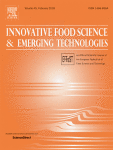Ver ítem
- xmlui.general.dspace_homeCentros e Institutos de InvestigaciónCIA. Centro de Investigaciones de AgroindustriaInstituto de Tecnología de AlimentosArtículos científicosxmlui.ArtifactBrowser.ItemViewer.trail
- Inicio
- Centros e Institutos de Investigación
- CIA. Centro de Investigaciones de Agroindustria
- Instituto de Tecnología de Alimentos
- Artículos científicos
- Ver ítem
High hydrostatic pressure assisted enzymatic hydrolysis of whey proteins
Resumen
Whey proteins, due to their high nutritional value, are generally hydrolyzed to reduce the allergenicity and used as ingredients in many special products, such as infant formulae, geriatric products, highly energetic supplements or dietetic foods or in foods produced to prevent nutrition related diseases, like food intolerances and allergies.
The aim of this work was to assess the applicability of innovative technologies, such as high hydrostatic
[ver mas...]
Whey proteins, due to their high nutritional value, are generally hydrolyzed to reduce the allergenicity and used as ingredients in many special products, such as infant formulae, geriatric products, highly energetic supplements or dietetic foods or in foods produced to prevent nutrition related diseases, like food intolerances and allergies.
The aim of this work was to assess the applicability of innovative technologies, such as high hydrostatic pressure (HHP) processes, to assist the enzymatic hydrolysis of target proteins, namely whey protein concentrate (WPC-80), in order to modify their antigenicity. Experiments were carried out to verify the effectiveness of HHP technology to accelerate whey protein hydrolysis reaction with selected enzymes (α-chymotrypsin, bromelain), and to affect the protein allergenic power. To this purpose, different HHP treatments were carried out at several pressure levels (100, 200, 300 and 400 MPa) and the untreated whey protein samples were used as control. A defined enzyme/substrate ratio of 1/10 w/w was used in the experiments, while the treatment time was changed from 0 to 30 min (0, 5, 15, or 30 min).
The experimental data demonstrated that High Hydrostatic Pressure (HHP) induced WPC-80 unfolding at the highest value of the pressure applied (400 MPa) as indicated by the higher exposure of free sulfhydryl groups. When HHP was used in combination with enzymatic hydrolysis, the degree of hydrolysis increased not only with the pressure level applied but also with the processing time. These results suggested that, even if the exposure of hidden epitopes upon protein unfolding increased the antigenicity of whey proteins, further peptide bonds cleavage also took place after hydrolysis. This effect could modify whey proteins antigenic sequences, and thus their antigenic power.
[Cerrar]

Autor
Fuente
Innovative food science & emerging technologies 38, Part B : 294-301. (December 2016)
Fecha
2016-12
ISSN
1466-8564
Formato
pdf
Tipo de documento
artículo
Palabras Claves
Derechos de acceso
Restringido
 Excepto donde se diga explicitamente, este item se publica bajo la siguiente descripción: Creative Commons Attribution-NonCommercial-ShareAlike 2.5 Unported (CC BY-NC-SA 2.5)
Excepto donde se diga explicitamente, este item se publica bajo la siguiente descripción: Creative Commons Attribution-NonCommercial-ShareAlike 2.5 Unported (CC BY-NC-SA 2.5)

